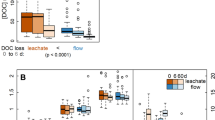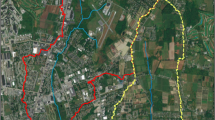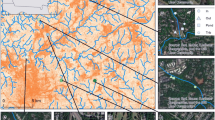Abstract
Stormwater runoff in urban areas can contribute high concentrations of dissolved organic matter (DOM) to receiving waters, potentially causing impairment to the aquatic ecosystem of urban streams and downstream water bodies. Compositional changes in DOM due to storm events in forested, agricultural, and urban landscapes have been well studied, but in situ sensors have not been widely applied to monitor stormwater contributions in urbanized areas, leaving the spatial and temporal characteristics of DOM within these systems poorly understood. We deployed fluorescent DOM (FDOM) sensors at upstream and downstream locations within a study reach to characterize the spatial and temporal changes in DOM quantity and sources within an urban water conveyance that receives stormwater runoff. Baseflow FDOM decreased over the summer season as seasonal flows upstream transported less DOM. FDOM fluctuated diurnally, the amplitude of which also declined as the summer season progressed. During storms, FDOM concentrations were rapidly elevated to values orders of magnitude greater than baseflow measurements, with greater concentrations at the downstream monitoring site, revealing high contributions from stormwater outfalls between the two locations. Observations from custom, in situ fluorometers resembled results obtained using laboratory methods for identifying DOM source material and indicated that DOM transitioned to a more microbially derived composition as the summer season progressed, while stormwater contributions contributed DOM from terrestrial sources. Deployment of a mobile sensing platform during varying flow conditions captured spatial changes in DOM concentration and composition and revealed contributions of DOM from outfalls during stormflows that would have otherwise been unobserved.










Similar content being viewed by others
References
Boyd, C. E. (2000). Water quality: an introduction. Boston: Kluwer Academic Publishers.
Burns, M. A., Barnard, H. R., Gabor, R. S., McKnight, D. M., & Brooks, P. D. (2016). Dissolved organic matter transport reflects hill slope to stream connectivity during snowmelt in a montane catchment. Water Resources Research, 52, 1–20. https://doi.org/10.1002/2015WR017878.
Carpenter, K. D., Kraus, T. E. C., Goldman, J. H., Saraceno, J. F., Downing, B. D., Bergamaschi, B. A., McGhee, G., & Triplett, T. (2013). Sources and characteristics of organic matter in the Clackamas River, Oregon, related to the gormation of disinfection by-products in treated drinking water. U.S. Geological Survey Scientific Investigations Report, 2013-5001, 78.
Casper, A. F., Dixon, B., Steimle, E. T., Hall, M. L., & Conmy, R. N. (2012). Scales of heterogeneity of water quality in rivers: insights from high resolution maps based on integrated geospatial, sensor and ROV technologies. Applied Geography, 32, 455–464. https://doi.org/10.1016/j.apgeog.2011.01.023.
City of Grand Junction. (2016). Grand junction municipal code volume II: Development regulations; Title 28: stormwater management manual; Chapter 28.52: Irrigation/drainage structures. Grand Junction, Colorado. http://www.codepublishing.com/CO/GrandJunction/html2/GrandJunction28/GrandJunction2852.html#28.52. Accessed 8 February 2017.
City of Logan. (2016). Storm water management plan. Logan, Utah. http://www.loganutah.org/SWMP%20Document%20Less%20Appendices_Final.pdf. Accessed 8 February 2017.
City of Sequim. (2016). Storm and surface water master plan. Sequim, Washington. http://www.sequimwa.gov/DocumentCenter/View/7735. Accessed 8 Februrary 2017.
Cory, R. M., Miller, M. P., McKnight, D. M., Guerard, J. J., & Miller, P. L. (2010). Effect of instrument-specific response on the analysis of fulvic acid fluorescence spectra. Limnology and Oceanography: Methods, 8, 67–78. https://doi.org/10.4319/lom.2010.8.0067.
Creed, I. F., McKnight, D. M., Pellerin, B. A., Green, M. B., Bergamaschi, B. A., Aiken, G. R., Burns, D. A., Findlay, S. E. G., Shanley, J. B., Striegl, R. G., Aulenbach, B. T., Clow, D. W., Laudon, H., Mcglynn, B. L., Mcguire, K. J., Smith, R. A., & Stackpoole, S. M. (2015). The river as a chemostat : fresh perspectives on dissolved organic matter flowing down the river continuum. Canadian Journal of Fisheries and Aquatic Sciences, 14, 1–14. https://doi.org/10.1139/cjfas-2014-0400.
Downing, B. D., Pellerin, B. A., Bergamaschi, B. A., Saraceno, J. F., & Kraus, T. E. C. (2012). Seeing the light: the effects of particles, dissolved materials, and temperature on in situ measurements of DOM fluorescence in rivers and streams. Limnology and Oceanography: Methods, 10, 767–775. https://doi.org/10.4319/lom.2012.10.767.
Dunbabin, M., & Grinham, A. (2010). Experimental evaluation of an autonomous surface vehicle for water quality and greenhouse gas emission monitoring. Paper presented at: IEEE International Conference on Robotics and Automation (ICRA). 5268–5274, May 3-8, Anchorage, AK, doi:https://doi.org/10.1109/ROBOT.2010.5509187.
Fellman, J. B., Hood, E., Edwards, R. T., & D’Amore, D. V. (2009). Changes in the concentration, biodegradability, and fluorescent properties of dissolved organic matter during stormflows in coastal temperate watersheds. Journal of Geophysical Research, 114, G01021. https://doi.org/10.1029/2008JG000790.
Gabor, R. S., Baker, A., McKnight, D. M., & Miller, M. P. (2014). Fluorescence indices and their interpretation. In P. G. Coble, J. Lead, A. Baker, D. M. Reynolds, & R. G. M. Spencer (Eds.), Aquatic organic matter fluorescence, Cambridge environmental chemistry series (pp. 303–338). Cambridge: Cambridge University Press. https://doi.org/10.1017/CBO9781139045452.015.
Hatt, B. E., Fletcher, T. D., Walsh, C. J., & Taylor, S. L. (2004). The influence of urban density and drainage infrastructure on the concentrations and loads of pollutants in small streams. Environmental Management, 34, 112–124. https://doi.org/10.1007/s00267-004-0221-8.
Hood, E., Williams, M. W., & Mcknight, D. M. (2005). Sources of dissolved organic matter (DOM) in a Rocky Mountain stream using chemical fractionation and stable isotopes. Biogeochemistry, 74, 231–255. https://doi.org/10.1007/s10533-004-4322-5.
Horsburgh, J. S., Tarboton, D. G., Maidment, D. R., & Zaslavsky, I. (2008). A relational model for environmental and water resources data. Water Resources Research, 44, W05406. https://doi.org/10.1029/2007WR006392.
Horsburgh, J. S., Reeder, S. L., Jones, A. S., & Meline, J. (2015). Open source software for visualization and quality control of continuous hydrologic and water quality sensor data. Environmental Modelling & Software, 70, 32–44. https://doi.org/10.1016/j.envsoft.2015.04.002.
Kaiser, K., Guggenberger, G., & Haumaier, L. (2004). Changes in dissolved lignin-derived phenols, neutral sugars, uronic acids, and amino sugars with depth in forested Haplic Arenosols and Rendzic Leptosols. Biogeochemistry, 70, 135–151. https://doi.org/10.1023/B:BIOG.0000049340.77963.18.
Keith, M. K., Sobieszczyk, S., Goldman, J. H., & Rounds, S. A. (2014). Investigating organic matter in Fanno Creek, Oregon, part 2 of 3: identifying and quantifying sources of organic matter to an urban stream. Journal of Hydrology, 519, 3010–3027. https://doi.org/10.1016/j.jhydrol.2014.07.027.
Lakowicz, J. R. (2006). Principles of fluorescence spectroscopy (3rd ed.). New York: Springer USA. https://doi.org/10.1007/978-0-387-46312-4.
Laudon, H., & Slaymaker, O. (1997). Hydrograph separation using stable isotopes, silica and electrical conductivity: an alpine example. Journal of Hydrology, 201, 82–101. https://doi.org/10.1016/S0022-1694(97)00030-9.
Lawaetz, A. J., & Stedmon, C. A. (2009). Fluorescence intensity calibration using the raman scatter peak of water. Applied Spectroscopy, 63, 936–940. https://doi.org/10.1366/000370209788964548.
Lee, E.-J., Yoo, G.-Y., Jeong, Y., Kim, K.-U., Park, J.-H., & Oh, N.-H. (2015). Comparison of UV-VIS and FDOM sensors for in situ monitoring of stream DOC concentrations. Biogeosciences, 12, 3109–3118. https://doi.org/10.5194/bg-12-3109-2015.
Lewis, J. (1996). Turbidity-controlled suspended sediment sampling and load estimation. Water Resources Research, 32, 2299–2310. https://doi.org/10.1029/96WR00991.
Low, K. H., Podnar, G., Stancliff, S., Dolan, J. M., & Elfes, A. (2009). Robot boats as a mobile aquatic sensor network. Paper presented at: Workshop on Sensor Networks for Earth and Space Science Applications (ESSA), Apr. 16, San Francisco, CA.
Lundquist, J. D., & Cayan, D. R. (2002). Seasonal and spatial patterns in diurnal cycles in streamflow in the Western United States. Journal of Hydrometeorology, 3, 591–603. https://doi.org/10.1175/1525-7541(2002)003<0591:SASPID>2.0.CO;2.
Mallin, M. A., Johnson, V. L., Ensign, S. H., & MacPherson, T. A. (2006). Factors contributing to hypoxia in rivers, lakes, and streams. Limnology and Oceanography, 51, 690–701. https://doi.org/10.4319/lo.2006.51.1_part_2.0690.
Marsh, P., & Woo, M.-K. (1981). Snowmelt, glacier melt, and high arctic streamflow regimes. Canadian Journal of Earth Sciences, 18, 1380–1384. https://doi.org/10.1139/e81-127.
Mazurkiewicz, A. B., Callery, D. G., & McDonnell, J. J. (2008). Assessing the controls of the snow energy balance and water available for runoff in a rain-on-snow environment. Journal of Hydrology, 354, 1–14. https://doi.org/10.1016/j.jhydrol.2007.12.027.
McElmurry, S. P., Long, D. T., & Voice, T. C. (2014). Stormwater dissolved organic matter: Influence of land cover and environmental factors. Environmental Science and Technology, 48, 45–53. https://doi.org/10.1021/es402664t.
McKnight, D. M., Boyer, E. W., Westerhoff, P. K., Doran, P. T., Kulbe, T., & Andersen, D. T. (2001). Spectrofluorometric characterization of dissolved organic matter for indication of precursor organic material and aromaticity. Limnology and Oceanography, 46, 38–48. https://doi.org/10.4319/lo.2001.46.1.0038.
Melcher, A. A., & Horsburgh, J. S. (2017). An urban observatory for quantifying phosphorus and suspended solids loads in combined natural and stormwater conveyances. Environmental Monitoring and Assessment, 2017, 189–285. https://doi.org/10.1007/s10661-017-5974-7.
Mihalevich, B. A., & Horsburgh, J. S. (2017a). Grab sample data for dissolved organic matter study in the northwest field canal. Logan: HydroShare. https://doi.org/10.4211/hs.a3a9ba772aac4cba9533b35bb6b5fe42
Mihalevich, B. A., & Horsburgh, J. S. (2017b). Mobile sensing platform data for dissolved organic matter study in the northwest field canal. Logan: HydroShare. https://doi.org/10.4211/hs.6711ca843bcc4834b51288a3ddc3aa08
Mihalevich, B. A., Horsburgh, J. S., & Melcher, A. A. (2017). Time series data for dissolved organic matter study in the northwest field canal. Logan: HydroShare. https://doi.org/10.4211/hs.c1be74eeea614d65a29a185a66a7552f
National Research Council. (2009). Urban stormwater management in the United States Committee on reducing Stormwater discharge contributions to water pollution. Washington, DC: The National Academies Press. 10.17226/12465.
Paul, M. J., & Meyer, J. L. (2001). Streams in the urban landscape. Annual Review of Ecology and Systematics, 32, 333–365. https://doi.org/10.1146/annurev.ecolsys.32.081501.114040.
Pellerin, B. A., Saraceno, J. F., Shanley, J. B., Sebestyen, S. D., Aiken, G. R., Wollheim, W. M., & Bergamaschi, B. A. (2012). Taking the pulse of snowmelt: In situ sensors reveal seasonal, event and diurnal patterns of nitrate and dissolved organic matter variability in an upland forest stream. Biogeochemistry, 108, 183–198. https://doi.org/10.1007/s10533-011-9589-8.
Podnar, G., Dolan, J. M., Low, K. H., & Elfes, A. (2010). Telesupervised remote surface water quality sensing, paper presented at: IEEE Aerospace Conference, 1–9. Mar. 6-13, Big Sky, MT, doi:https://doi.org/10.1109/AERO.2010.5446668.
Saraceno, J. F., Pellerin, B. A., Downing, B. D., Boss, E., Bachand, P. A. M., & Bergamaschi, B. A. (2009). High-frequency in situ optical measurements during a storm event: assessing relationships between dissolved organic matter, sediment concentrations, and hydrologic processes. Journal of Geophysical Research, 114, G00F09. https://doi.org/10.1029/2009JG000989.
Saraceno, J. F., Shanley, J. B., & Aulenbach, B. (2016). Multi-site field verification of laboratory derived FDOM sensor corrections: the good, the bad and the ugly. Abstract H11B-087 presented at: 49th Annual AGU Fall Meeting, Dec. 12-16, San Francisco, CA.
Saraceno, J. F., Shanley, J. B., Downing, B. D., & Pellerin, B. A. (2017). Clearing the waters: evaluating the need for site-specific field fluorescence corrections based on turbidity measurements. Limnology and Oceanography: Methods, 15, 408–416. https://doi.org/10.1002/lom3.10175.
Spencer, R. G. M., Pellerin, B. A., Bergamaschi, B. A., Downing, B. D., Kraus, T. E. C., Smart, D. R., Dahlgren, R. A., & Hernes, P. J. (2007). Diurnal variability in riverine dissolved organic matter composition determined by in situ optical measurement in the San Joaquin River (California, USA). Hydrological Processes, 21, 3181–3189. https://doi.org/10.1002/hyp.6887.
Stedmon, C. A., Markager, S., & Bro, A. (2003). Tracing dissolved organic matter in aquatic environments using a new approach to fluorescence spectroscopy. Marine Chemistry, 82, 239–254. https://doi.org/10.1016/S0304-4203(03)00072-0.
U.S. Census Bureau, Population Division (2016). Annual estimates of the resident population: April 1, 2010 to July 1, 2015. https://factfinder.census.gov/faces/tableservices/jsf/pages/productview.xhtml?src=bkmk. Accessed 26 April 2017.
Utah Depatment of Environmental Quality, Division of Water Quality (2004). Utah’s 2004 303(d) list of impaired waters, Salt Lake City, UT.
Utah Depatment of Environmental Quality, Division of Water Quality (2010). Middle Bear River and cutler reservoir total maximum daily load (TMDL), Salt Lake City, UT.
iUTAH GAMUT Working Group (2017a). iUTAH GAMUT Network Quality Control Level 1 Data at Climate Station at Logan River Golf Course (LR_GC_C), HydroShare, http://www.hydroshare.org/resource/86a27290e1b443a488f0b84cb9e2af91.
iUTAH GAMUT Working Group (2017b). iUTAH GAMUT Network Quality Control Level 1 Data at Logan River at the Utah Water Research Laboratory west bridge (LR_WaterLab_AA), HydroShare, http://www.hydroshare.org/resource/1b87fe7452624e82a54fa57432b17583.
Utah Office of Administrative Rules (2017). R317–2. Standards of quality for waters of the state. Salt Lake City, UT.
Watras, C. J., Hanson, P. C., Stacy, T. L., Morrison, K. M., Mather, J., Hu, Y.-H., & Milewski, P. (2011). A temperature compensation method for CDOM fluorescence sensors in freshwater. Limnology and Oceanography: Methods, 9, 296–301. https://doi.org/10.4319/lom.2011.9.296.
Funding
This work was supported by funding from the Utah Water Research Laboratory at Utah State University and from the US National Science Foundation under EPSCoR grant IIA-1208732 awarded to Utah State University as part of the State of Utah EPSCoR Research Infrastructure Improvement Award. Any opinions, findings, and conclusions or recommendations expressed in this material are those of the authors and do not necessarily reflect the views of the National Science Foundation.
Author information
Authors and Affiliations
Corresponding author
Rights and permissions
About this article
Cite this article
Mihalevich, B.A., Horsburgh, J.S. & Melcher, A.A. High-frequency measurements reveal spatial and temporal patterns of dissolved organic matter in an urban water conveyance. Environ Monit Assess 189, 593 (2017). https://doi.org/10.1007/s10661-017-6310-y
Received:
Accepted:
Published:
DOI: https://doi.org/10.1007/s10661-017-6310-y




